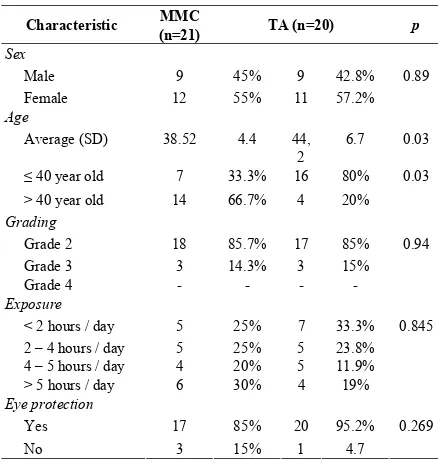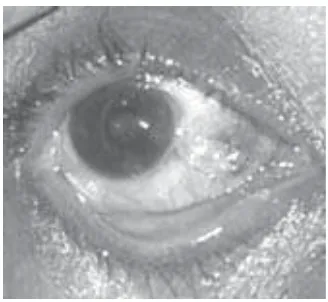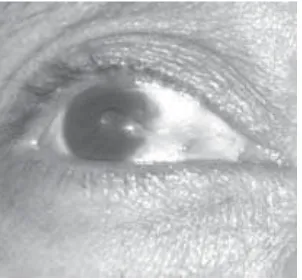Effectiveness of subconjunctival
mitomycin-C compared with subconjunctival
triamcinolon acetonide on the recurrence of
progresive primary pterygium which
underwent Mc Reynolds method
Donny W Chandra, Agus Supartoto, Angela Nurini Agni Department of Ophthalmology
Faculty of Medicine Gadjah Mada University/Dr. Sardjito Hospital Yogyakarta
ABSTRACT
Donny W Chandra, Agus Supartoto, Angela Nurini Agni.- Effectivity of subconjunctival mitomycin-C compared with subconjunctival triamcinolon acetonide on the recurrence of progresive primary pterygium which underwent Mc Reynolds method
Background: The main problem in the management of pterygium is how to diminish the recurrence rate after surgical treatment. Mitomycin-C an antineoplastic, antifibrotic has been used to prevent recurrence rate of pterygium after excision, however, it correlated with some complications. Subconjunctival administration before excision has been proposed to avoid them.
Objective: To know the effectivity of subconjunctival of mitomycin-C to decrease the recurrence rate of progresive primary pterigyum after Mc Reynold method compared with subconjunctival triamcinolon acetonide.
Materials and methods: Randomized clinical trial of 41 progresive primary pterygium in Dr Sardjito Hospital and Dr Yap Eye Hospital. They were randomly assigned to receive subconjunctival 0.1 ml triamcinolon acetonide or 0.1 ml mitomycin-C and underwent pterygium excision one week later using Mc Reynold method. The follow up period was 6 months to detect any recurrence and complication of the drugs
Results: The recurrence rate after subconjunctival mitomycin-C and triamcinolon acetonide was 4.7% and 25%, respectively, however the different was not statistically significant (p=0.67). There were no statistical difference in conjunctival hiperemia, lacrimation and granulation. Blepharospasm was significantly different in seven days. The pain after injection and after excision was statistically different between two two groups.
Conclusion: The recurrence rate of progressive primary pterygium in triamcinolon acetonide group was higher than mitomycin-C group but there was no statistical difference.
ABSTRAK
Donny W Chandra, Agus Supartoto, Angela Nurini Agni : Perbandingan hasil guna mitomycin C subkonyungtiva dengan triamcinolon subkonyungtiva terhadap kekambuhan pterigium primer progresif yang dioperasi dengan metoda Reynolds
Latar belakang: Masalah utama dalam penanganan pterigium adalah bagaimana mengurangi kejadian kekambuhan setelah operasi. Mitomycin-C bersifat antineoplastik dan antifibrotik telah diketahui dapat menghambat kejadian kekambuhan, tetapi berkaitan dengan terjadinya beberapa komplikasi. Pemberian obat secara subkonjungtiva sebelum operasi diharapkan dapat mengurangi kekambuhan tersebut.
Tujuan : Penelitian ini bertujuan untuk mengetahui hasil guna mitomycin-c subkonjungtiva dalam mengurangi kekambuhan pterigium primer progresif sebelum dilakukan operasi Mc Reynold dibanding triamcinolon acetonide subkonjungtiva
Bahan dan cara: Dilakukan uji klinis acak dilakukan terhadap 41 pasien rawat jalan pterigium primer progresif di RS Dr Sardjito dan RS Mata Dr Yap. Setelah alokasi acak, dilakukan perlakuan injeksi 0,1 ml mitomycin-C atau triamcinolon asetonid subkonjungtiva dan setelah 1 minggu dilakukan eksisi dengan metode Mc Reynold. Pengamatan dilakukan selama 6 bulan untuk mendeteksi kekambuhan dan komplikasi obat.
Hasil: Kekambuhan pterigium pada kelompok perlakuan mitomycin-C dan triamcinolon asetonid sukonjungtiva masing-masing adalah 4,7% dan 25% tetapi tidak bermakna secara statistik (p=0,67). Tidak didapatkan perbedaan bermakna pada hiperemia konjungtiva, lakrimasi, dan pembentukan jaringan granulasi. Blefarospasme berbeda secara bermakna dalam tujuh hari. Rasa nyeri setelah injeksi dan setelsh operasi pada kedua kelompok berbeda secara bermakna.
Simpulan: Angka kekambuhan pterigium primer progresif pada kelompok triamcinolon asetonid lebih tinggi daripada kelompok mitomycin-C meskipun tidak bermakna secara statistik.
INTRODUCTION
Pterygium is a growth of fibrovascular tissue from conjunctiva and subconjunctiva bulbi extending and infiltrates the surface of the cornea with apex growing toward the pupil.1,2,3,4,5 The growth of pterygium is flat on canthal area at the nasal side sometime to temporal side, in the form of triangle and divided into apex, collum, and corpus. Geographically, pterygium is at most found in the tropical climates. Indonesia having equator climates has high risk to develop pterygium.8
Pterygium is still a difficult problem and hard to overcome because of high recurrence rate post operatively.3,5,9,10 Recurrence rate in Indonesia is about 35 – 52%.11 Research in Cipto Mangunkusumo Hospital found recurrence rate of 65% at the age below 40 years old and 12.5% at the age over 40 years old.8 The reason of pterygium recurrence can be explained with (1) Theory of neoplastic, (2) Theory of degeneration, (3) Theory of inflammation, and (4) Theory of immunology.12,13,14
Surgery is the main treatment for pterygium. There are many variations of pterygium surgery method. The most common method used to remove pterygium is Mc Reynold method. In this technique
the apex of pterygium is excised and buried into conjunctival sac next to caudal limbus and it would be stitched, following the removal of subconjunctival tissue that covered cornea. It is expected that if pterygium regrowrh is unavoidable would be toward conjunctival sac.
The role of steroid in suppressing leucocyte activity and decreasing vascular permeability will decrease tissue disruption, decrease mitogen and growth factor and also interupts clot and fibrin production. This will disrupt the minimal fibroblast activity.19
Mitomycin C is an antiproliferative agent and a potent fibroblast proliferation suppressor by suppressing DNA synthesis and its function. It also acts as antineoplastic, antibiotic, and antimetabolit agent. Donnenfeld and colleagues stated that the use of preoperative subconjunctival mitomycin C was safe and effective as adjunctive therapy. It could suppress the recurrence rate with minimal complication.
The aim of this study was to know the effecti-veness of preoperative subconjunctival mitomycin C compared with preoperative subconjunctival tramcinolon acetonide in decreasing the recurrence rate of progressive primary pterygium removed by
MATERIAL AND METHODS
This study was a randomised clinical trial. The subjects were patients who came to the Ophthalmology Departement Dr. Sardjito Hospital and Dr Yap Eye Hospital, Yogyakarta, in August 2005 - April 2007 that fulfilled inclusion criteria. The inclusion criteria were patient who had progressive primary pterygium either unilateral or bilateral, age less than 50 years old, Youngson clinical grade 2 or more, no history of eye surgery, no history of topical steroid or injection usage in last 4 weeks, no history of dry eye syndrome, willing to participate in this study by signing the informed consent. Subject was disqualified or dropped out from this study if the subject never presented to control after surgery or they did not obey the medication instruction during the study. Consecutive sampling and block randomization was performed in this study. Sample size was calculated based on Lameshow formula with recurrence rate proportion for preoperative subconjunctival triamcinolon acetonide group of 45% and recurrence rate proportion for preoperative subconjunctival mitomycin C group of 6% with assumption α was 0.05 and β was 0.20. Sample size for each group was 22. Subjects that fulfilled the inclusion criteria were asked to sign the informed consent after given explanation. History taking was performed and consisting of age, sex, occupation, disease history, medication history, history of sunblock usage before and during sun exposure. Eye examination consisted of routine ophthalmology examination, biomicroscopy examination, grading of pterygium based on Youngson, Schirmer test 1 for tear secretion function. Both groups were given tetracain hydrochloride 2% eye drop on the eye that whould be injected. Lidocain 0.1% of 0.2 mL was injected into conjunctiva until it distended with the border of apex pterygium was on limbus area and waited for five minutes. Conjunctiva was then injected with mitomycin C or triamcinolon acetonide with 0.1 mL insulin syringe. Ofloxacin 0.3% eye drop was given 4 times daily. After a week, the pterygium was excised, from the cornea widened toward upper and lower limbus. The corpus was excised by beaver blade. Undermined subconjuncti-vally inferior to cornea. Pterygium apex was inserted subconjunctivally inferior to limbus and it was sutured by silk 4.0. Foloowing surgery, every subject received ofloxacin eye drop 4 times daily and
week. Mefenamic acid 500 mg was given orally 3 times daily for a day. The patient was recommended to use eye protection such as glasses, and hat. Suture would be released on the 7th day. Recurrences were evaluated on the 14th day, and after one, two, three, and six months. Demographic data consisting of age, sex, exposure to external factor were analyzed with descriptive statistics. Recurrence rate was analyzed with chi-square test.
RESULTS AND DISCUSSION
There were 44 subjects participated in the study. Three subjects were dropped out (2 on triamcinolon acetonide group and 1 on mitomycin C group). Therefore, only 41 subjects were involved in this study. Subject characteristics in this study consisting sex, grading of pterygium, duration of sun exposure and eye protection usage were similar mitomycin C group (35.52 ± 4.4) was significantly younger than triamcinolon acetonide group (44.2 ± 6.7 years). (TABLE 1)
TABLE 1. Subject characteristics
Note : MMC : Mitomycin-C, TA : Triamcinolon acetonide, SD : Standard deviation
Characteristic MMC
eventhough it was not statistitically significant (p=0.067).
Recurrence time for mitomycin C group was sligthly longer (three months) compared with the average recurrence time for triamcinolon acetonid group (2.8 ± 0.4 months) eventhough no statistical significant difference was found (p>0.05). Triamcinolon acetonide group showed greater risk of recurrence than mitomycin C group (OR = 1.94; 95%CI=1.15–3.28). However this value was influenced by age factor distribution of both groups.
In order to gain recurrence risk for both group by eliminate age predisposing factor, summary odds ratio with Mantell Haenzel was done with OR value=11.635 (95%CI=0.61-220.15) and p value=0.21, statistically not different. 95%CI showed clinically inconclusive, but it showed the tendency of difference. This was due to too small sample size. Recurrence proportion for mitomycin C group was 6% and for triamcinolon acetonide group was 45% that cause difference of 4% compared with 25% lead to not statistically significant different. In this study the power was 55.8%. It means there was 41.2% for type 2 error.
In this study, hyperemia of conjunctiva in mitomycin C group was not statistically significant different compared with triamcinolon acetonide group on 7th (p=0.30) vs 14th (p=0.22) day. Lacrimation for mitomycin C group was not statistically significant different compared with triamcinolon acetonide group on 7th (p=0.315) vs 14th day (p=0.07). Blepharo-spasm in mitomycin C group was statistically significant different compared with triamcinolon acetonide group on 7th day (p=0.001) but it was not significant different on 14th day (p=0.067). Subject of mitomycin C group felt more painful compared with triamcinolon acetonide group. Pain sensation was measured with visual analog scale whereas average rate of pain sensation for mitomycin C was 2.19 ± 0.67 and triamcinolon acetonide group was 1.7 ± 0.65. In our study, pain sensation for both group were statistically significant different post antimetabolites injection (p=0.024), on 7th day (p=0.029), 14th day (p=0.024). Granulation was not statistically significant different for both groups (p=0.32), eventhough the granulation occurred in one patient of mitomycin C group. This complication probably can be caused by the usage of 4.0 silk suture that eventhough nonantigenic and nonpyrogenic
irritation reaction was common. No granulation in triamcinolon acetonide group.
FIGURE 1. Pterygium recurrences in 6 month evaluation.
Asfani et al. found that recurrence rate for pterygium injected with mitomycin C subconjunctivally durante excision surgery was 13.8% compared with triamcinolon acetonide subconjunctivally was 17.2%.18 Donnenfeld et al. in their study reported that recurrence rate in pterygium injected with 0.1 mL mitomycin C subconjunctivally preoperative was 6% with recurrence time appeared in a month. In this study, recurrence rate in mitomycin-C subconjunctiva preoperative was 4.7%, lower compared to study of Asfani et al. and of Donnenfeld et al. Recurrence time in this study (3 month) was longer than Donnenfeld study (1 month).17
FIGURE 2. Hyperemia conjungtiva on 7th day post operative in progressive primary pterygium
CONCLUSION
Recurrence rate for triamcinolon acetonide subconjunctiva group was clinically higher compared to mitomycin-C group in progressive primary pterygium patients, eventhough no statistical significant difference. Average recurrence time in triamcinolon group was sligthly faster compared to mitomycin C group, but not statistically significant different. Probability recurrence for triamcinolon acetonide group was 11.6 times than mitomycin C group with OR value 11.6 (95%CI=0.61-220.1).
There was no statistically significant difference for conjunctival hyperemia, and lacrimation on 7th and 14th day. Blepharospasm was significant different on 7th day, but not on 14th day. Pain sensation was statistically significant different post injection, on 7th , 14th day after surgery (p<0.05). Patients injected with mitomycin C felt more painful than triamcinolon acetonide group Granulation occurred in one patient (4.7%) mitomycin C group but not found in triamcinolon group.
REFERENCE
1. Holland EJ, Mannis MJ. Pterygium in Ocular Surface Disease Medical and Surgical Management. New York: Springer-Verslag, 2002:65-91.
2. Buratto L, Phillips RL, Carito G. Pterygium Surgery.Italy: Slack Incorporated, 2000.
3. Adamis AP, Struck I, Kenyon KR. The Management of Pterygium. Ophthalmol Clin of North American 1990;3(4):611-15.
4. Rivhaard LA. Surgical Intervention in Corneal and External Diseases. Orlando : Grune&Sratton Inc, 1987.
5. Duke ES. System of Ophthalmology. London : Henry Kimpton, 1965;VII(1).
6. Bhatti SM. Pterygium Removal : Knife excision versus modified evolution technique.Ophthalmic Surg 1994;25:383-85.
7 Barraquer JL. Etiology, Pathogenesis and Treatment of the Pterygium.Proceeding of the Medical and Surgical Disease of the Cornea symposium. St. Louise Missouri : CV Mosby Co, 1980:167-78.
8. Prakoso H, Darmayanti, Syamsurizal. Kekambuhan Pterigium pada berbagai Operasi.Proceeding of the Konas Perdami, Semarang: Prakoso, 1988.
9. Haik GM. The Management of Pterygia : a Third Report on a Combined Surgical Irradiation Technique. Am J Ophthalmol 1996;61.
10. Abraham EP. Text Book of General Pathology .4th ed. Loyd WKC, 1990.
11. Oka PN, Liman. Pterigium dan Kekambuhannya. MKI 1973;11-12 :199-203.
12. Widagdi S. Umur dan Jenis Gambaran Patologi Anatomi sebagai Resiko Kekambuhan Pterigium. Karya Akhir PPDS I FK-UGM, Yogyakarta 1994 (not publeshed, Perpustakaan Bagian Mata FKUGM) .
13. Kamel S. The Pterygium, Its Etiology and Treatment. Am J Ophthalmol 1984:38.
14. Pinkerton OD, Hokama Y, Shigemura LA. Immunologic Basic for the Pathogenesis of Pterygium.Am J Ophthalmol 1984;98:225-28.
15. Junaedi M. Perbandingan Pengaruh Operasi Pterigium dengan Metode Bare Sklera dan Mc. Reynolds terhadap Astigmat Kornea. Karya Akhir PPDS I Ilmu Penyakit Mata FK UGM 1992 (not publeshed, Perpustakaan Bagian Mata FKUGM) .
16. Cliova B, Atanosova.Pathogenesis of Pterygium. Folia Medica 1971; XII: 67 – 73
17. Donnenfeld ED, Perry HD, Fromer S, Doshi S, Solomon R, Biser S. Subconjunctival Mitomycin C as Adjunctive Therapy before Pterygium Excision. Ophthalmology 2003;110:1012-26.
18. Asfani S, Agus Supartoto, Angela Nurini Agni, Suhardjo. Daya guna triamsinolon asetonid subkonjungtiva dibanding mitomisin-C terhadap kekambuhan pterigium primer. Berkala Kesehatan Klinik 2002;VII(2);43 – 47. 19. Lam DS, Wong AK, Fan DS. Intraoperative MMC to Prevent Recurrence of Pterygium After excision, a 30 mo Follow up Study, Ophthalmology 1998:901-7. 20. American Academy of Opthalmology, Basic and Clinical
Science.sect. 8., San Fransisco: American Academy of Opthalmology, 2000-2001.
21. Soedarmanto M., Perbandingan Efektivitas antara Metode Transplantasi Autograft Limbus Konjungtiva dan Mc Reynolds . Karya akhir PPDS I FK-UGM. Yogyakarta 2003 (not publeshed, Perpustakaan Bagian Mata FKUGM) ..
22. Cheng HC, Tseng SH, Kao PL. Low Dose Intraoperative Mitomycin C as Chemoadjuvant for Pterygium Surgery .Cornea 2001;20(1):24-29.
23. Prayitnaningsih P. Perbandingan Efektivitas antara FIGURE 3. Pterygium recurrence in triamcinolon acetonide
Metode Bare Sklera dan Mitomycin C Intraoperatif. Karya akhir PPDS I FK-UGM.Yogyakarta 2002 (not publeshed, Perpustakaan Bagian Mata FKUGM) . 24. Avisar R, Gaton DD, Loya N. Intraoperative Mitomycin
C 0,02% for Pterygium : Effect of Duration of Application on Recurrence Rate.Cornea 2003;22(2):102-4.
25. Jaros PA, Luise VP. Pingueculae and Pterygia .Eye Surv Ophthalmol 1998;33:41-47.
26. Sharma JL, Pimas IP, Singh M. Hereditery Pterygium. Philipine J Ophthalmol 1988;33:93-04.
27. Hill JC, Maske R. Pathogenesis of Pterygium.Eye 1989;3:218-26.
28. Oldenburg JB, Garbus J, Donnell PJ. Conjunctival Pterygium : Mechanism of Corneal Topographic Changes .Cornea 1990;3:200-2004.
29. Friedenwald JS.Text Book of Ophthalmic Pathology.3rd ed. Philadelphia: WB Saunders Company,1952. 30. Gondowihardjo TD, Characterization of Human Corneal
Aldehyde Dehidrogenase. Amsterdam:University of Amsterdam, 1992.
31. Grayson M. Disease of the Cornea. London : CV Mosby Company, 1983.
32. Gerundo M. The Etiology and Pathology of Pterygium. Am J Ophthalmol 1988;34:851-6.
33. Hogan MJ, Alvredo J. Pterygium and Pingueculae : Microscopic Study. Arch Ophthalmol 1987;97(80):174-86.
34. Berman ER. Biochemistry of the Eye. New York:Plenum Press,1991:36-41.
35. Brutus ST, Ashraf MF, Laby DM.Increased Number of Mast Cell in Pterygia. Am J Ophthal mol 1995:236-37. 36. Yuko K. Morphological Study on the Pathogenesis of
Pterygium. Acta Soc Ophthalmol 1987;91:324. 37. Ratnakar KS. Mast Cells and Pterygium. Acta
Ophthalmol 1976;54:363.
38. Helal M, Messiha N, Amayem A. Intraoperative Mitomycin C vs Postoperative Topical Mitomycin Drops for the Treatment of Pterygia. Ophthalmic Surgery and Lasers 1996;27(8); 674-78.
39. Verma N, Garap JA, Maris R. Intraoperative Use of Mitomycin C in the Treatment of Recurrent Pterygium. PNG Med J 1998:37-42.


